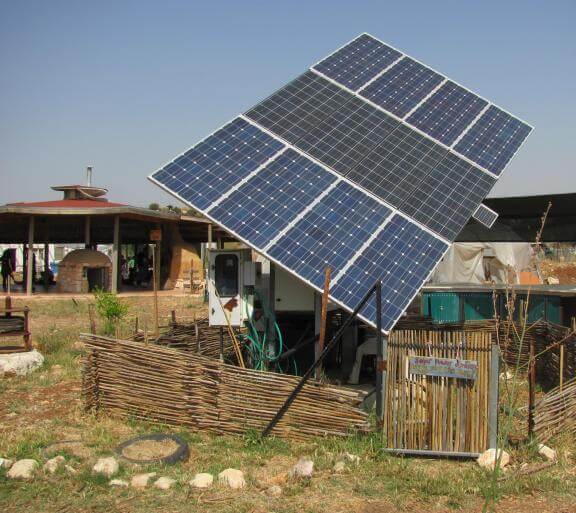"Following the sharp drop in the prices of photovoltaic solar panels in recent years, an opportunity has arisen to switch to the production of clean, available and cheap electricity that originates from solar energy instead of coal-fired power plants that pollute the environment," says Professor Avner Rothschild from the Faculty of Materials Science and Engineering at the Technion.

Technion and EPFL (École polytechnique fédérale de Lausanne) researchers have reached a new peak in the rate of conversion of solar energy into hydrogen by breaking down water using iron oxide (rust) electrodes with a special nanometer structure. Combined with photovoltaic solar panels, these electrodes will be able to produce hydrogen while the solar panel produces electricity in order to store the excess solar energy during the day and convert it into electricity during the dark hours.
"Following the sharp drop in the prices of photovoltaic solar panels in recent years, an opportunity has arisen to switch to the production of clean, available and cheap electricity that originates from solar energy instead of coal-fired power plants that pollute the environment," says Professor Avner Rothschild from the Faculty of Materials Science and Engineering at the Technion. "Last year, solar panels were installed in Europe that produce electricity with a greater power than all the new power plants, which were installed all over Europe at the same time, to produce electricity from both coal and natural gas. The main technological barrier facing a large-scale transition from polluting electricity production through the burning of coal and natural gas to clean electricity production through solar energy stems from the need to bridge the gap between electricity production during the day, when the sun shines, and electricity consumption during the evening, night and early morning hours when the energy source , that is, sunlight is not available."
With the help of sunlight, iron oxide electrodes can break down the water molecules into hydrogen and oxygen efficiently and potentially cheaply. The hydrogen generated during the day can be stored and converted into electricity during the dark using a hydrogen fuel cell. Alternatively, it can be used as a raw material for the production of other materials with added value, such as ammonia for the chemical fertilizer industry or liquid fuel for transportation.
In the current work, published in the prestigious scientific journal Nature Materials, Dr. Scott Warren, a post-doctoral student in the research group of Prof. Michael Grätzel from EPFL, discovered that there is a clear connection between the structure and arrangement of the nanoscale particles The complexity of the electrodes and the rate at which they are able to break down water and produce hydrogen and oxygen using sunlight. A slight change in the preparation conditions of the electrodes resulted in a special structure in which the particles are uniformly arranged as opposed to their random arrangement in the normal preparation process of the electrode. As a result, the rate of hydrogen production increased by about thirty percent, compared to the previous record, and reached a new record of about 17 liters per hour per electrode in an area of one meter by one meter. "At such a rate," explains Professor Rothschild, "it will be possible to refuel a hydrogen vehicle using a home solar system which will also provide, in addition to hydrogen, all the electricity consumption of an average family in Israel."
"The high efficiency of the new electrodes, which have an orderly structure, is due to the reduction of the resistance to the passage of an electric current through them," explains Chen Dotan, a doctoral student in Professor Rothschild's research group and one of the authors of the article. "As a result, the electric charge created due to the absorption of light in the electrode is able to break down the water molecules more effectively than in the previous electrodes, which have an irregular structure, where the electric charge loses potential as it passes from particle to particle."
This work joins previous work from Professor Abner Rothschild's research group, also published in Nature Materials last year, in which the researchers were able to improve the efficiency of electrodes made of an extremely thin layer, approximately 25 nm thick, of iron oxide by trapping light in the layer . These works mark new and promising breakthroughs, indicating that it is possible to use iron oxide - a simple, common, cheap, and stable material - for the conversion and storage of solar energy and the production of clean synthetic fuel that does not pollute the environment and does not contribute to the greenhouse effect. The research on this subject is supported by the energy program of Shem Grand, the center of excellence for solar fuel, and the FTA program in nanophotonics.
Reference to the (new) article:
Scott C. Warren, Kislon Voïtchovsky, Hen Dotan, Celine M. Leroy, Maurin Cornuz, Francesco Stellacci, Cécile Hébert, Avner Rothschild and Michael Grätzel, 'Identification of champion nanostructures for solar water-splitting', Nature Materials online edition, July 7 , 2013.

4 תגובות
Thank you "one". I really wondered to this day what Kurzweil's position was on the issue of future energy. After all, quite a bit of it is needed to start the processes he predicts.
How do you separate the hydrogen from the oxygen before everything explodes? For those who don't know, a mixture of 2 parts hydrogen and XNUMX part oxygen is called thunder gas, and not for nothing.
"Following the sharp drop in the prices of photovoltaic solar panels in recent years..."
So compatible with Ray Kurzweil's predictions, according to him solar energy will be able to provide all of humanity's energy needs in about 20 years and at a lower cost than oil and gas:
http://www.kurzweilai.net/glenn-beck-interviews-ray-kurzweil-may-2008
It is important to combine the hydrogen production technology with its safe storage. In the past, several articles on the subject were published on the site.